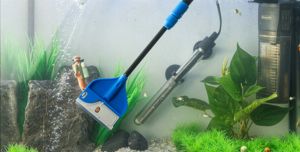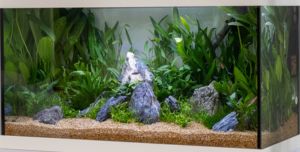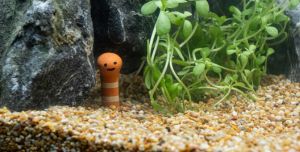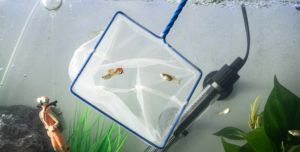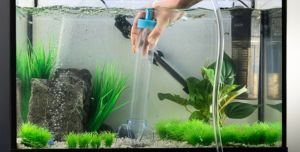Aquarium maintenance
Regular aquarium maintenance is essential for the health and wellness of your fish. Without it, your fish could suffer from a whole host of health issues. Whether you have a freshwater or tropical aquarium, the process is virtually the same.
Do aquariums require a lot of maintenance?
As you might expect, aquariums need a fair share of maintenance to keep them clean and functioning. The good news is that there are plenty of tools and routines to keep your tank fresh without any major upkeep.
What equipment will I need for aquarium maintenance?
To get the most out of your aquarium, you’ll want to invest in tools such as
- Hose
- Gravel vacuum cleaner
- Algae scraper
- Water bucket
- Water test kit
- Plant scissors & tweezers (if you have a planted aquarium)
- Thermometer
- Water conditioner
- Fish net
Weekly aquarium maintenance
Each week, you should perform basic maintenance on your tank:
- Clean the inside glass of your aquarium glass. If the outside needs cleaning, use water and a soft cloth. Avoid abrasive cloths or chemical products.
- Regularly top up the water level to replace any evaporation
- Treat new water with Bioactive Tapsafe before adding it to the aquarium.
- If you have live plants, feed them with a specialist aquarium plant food.
- Clean the LED lights, using water and a soft cloth – make sure to turn them off a few minutes before cleaning.
Monthly aquarium maintenance
To ensure the health of your aquarium inhabitants, it’s important to test the water levels for ammonia, nitrite, nitrate, and pH. Specific test kits make this task easy.
- Perform a 25% water change using a gravel cleaner to clean the substrate by following the steps outlined in ‘Doing a water change‘ and then use Bioactive Tapsafe.
- Replace your filter cartridge or clean the filter foams in a bucket of aquarium water every month.
- Add a dose of Fast Filter Start to promote the growth of important bacteria.
- If you have live plants in your aquarium, give them some attention by trimming them and removing any dead leaves.
Every Three Months aquarium maintenance
You should give your filter a good clean once every three months in aquarium water.
- Start by syphoning a small amount of aquarium water into a bucket, then turning off the power and removing the filter from the tank into the bucket.
- Unclip the intake cage and rinse, making sure to remove any dead leaves or large pieces of dirt that may be trapped in the intake grills.
- Reinstall the cleaned filter into the aquarium, once it’s running, it’s time to do some general maintenance.
- Cleaning the walls of the tank with an algae scraper, and remove any dirt or debris from the gravel.
- Do a large water change by replace 40-50% of the water. Use fresh, clean water that has been treated with Bioactive Tapsafe at the correct water temperature for your fish species.
How often should I change the water in my aquarium?
A 20% water change should be done at least once every month, as well as replacing the filter cartridge. Always use Bioactive Tapsafe when using tap water. Make sure to check on your filter to ensure everything is operating as usual.
How to test aquarium water
To keep a health aquarium, one of the things you must do often is test your water. Fortunately, it’s an easy process that can be done with the right tools and equipment. For more information, check out ‘Testing your aquarium water‘.
First, purchase a water test kit. This includes test strips to measure the pH, ammonia, nitrite, and nitrate levels in the water. It’s worth learning about these levels, so that you know when they are too low or too high.
Once you have your test kit, you simply need to follow the instructions included to accurately measure the water. If any of the levels are outside the ideal range for your fish, you will then need to adjust them accordingly.
How often should I test my aquarium water?
Once a month is an ideal amount to make sure everything is healthy. You’ll want to focus on the main indicators, such as pH, nitrite, ammonia, and nitrate.
Your fish’s behaviour or appearance can also be a sign that things are askew, so be sure to take a close look at them every now and then. If you’re ever in doubt about your water, take a sample and test it.

